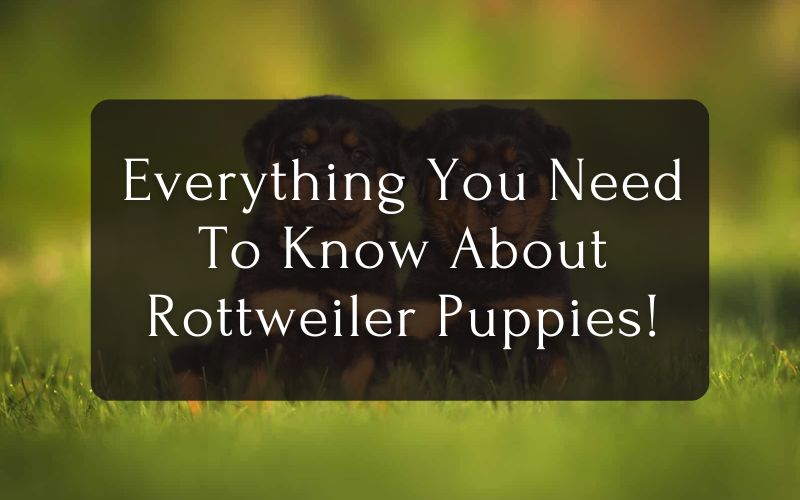Even though Rottweiler is no longer an unfamiliar name in the dog breed market, this dog breed is still a lovely choice for people who want to adopt a cute and loyal pet. In this post, we are going to provide you with a guide on how to take proper care of Rottweiler puppies. Scroll down for information about their behaviour, personality, and health issues!
About The Rottweiler Puppies
- The History Behind Rottweilers:
Rottweilers descend from a line of herding dogs, which explains a lot about their characteristics (which we will discuss later). Specifically, their ancestors – the Molossus mastiff dogs held the responsibility of rounding up the Roman cattle on their trip to Germany ( the homeland of the miniature Dachshund).
On their journey, the Molossus was mixed with a lot of other local dogs; one such breed was the Rottweilers which were named after the Southern German market area where they continued the herding work of the Molussus. However, the newly developed rail transportation and Rottweilers were almost extinct due to the breed’s job being taken away by the newly developed rail transportation.
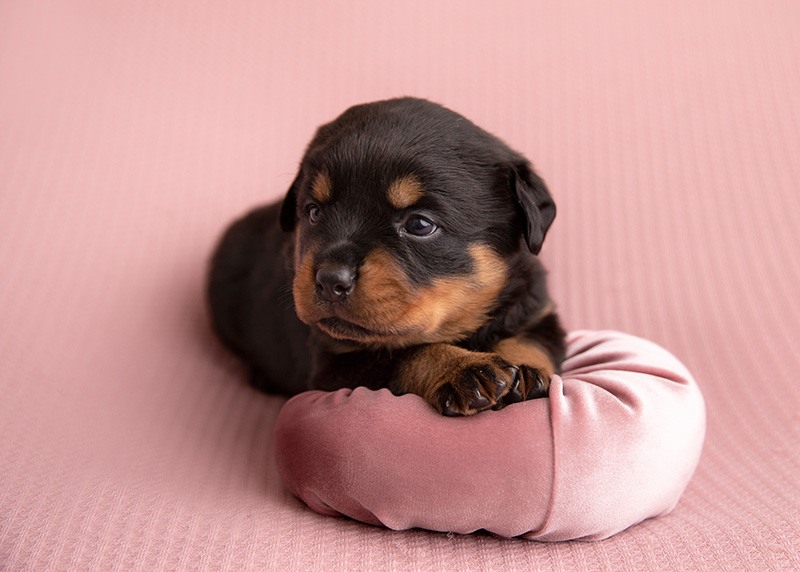
Luckily, the Rottweiler and Leonberger Club, along with their breed standards, was founded and saved the Rottweilers from falling out of favour with the public.
Nowadays, we no longer see Rottweilers with their work in the field but rather among policemen and active families. The dogs’ hard work personality is shaped by the responsible and ethical breeders and the standards from relevant dog clubs.
- How Do They Look?
A male Rottweiler can be very bulky and muscular; its shoulder length can measure up to 24-27 inches. A Rottweiler can be recognized by its shiny, short, black coat and strong, fast gait.
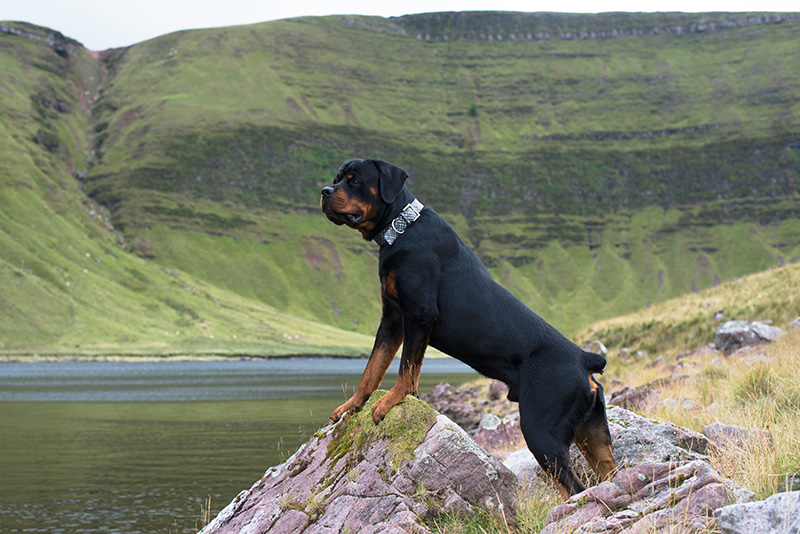
When compared to other breeds, such as Black Pug or Yellow Lab, you’ll notice that Rottweilers are average in size. They have slight rusty markings like Siberian Husky puppies on their fur, so they’re not completely dark like Cane Corso puppies. Overall, Rottweilers usually appear to be very strong, agile, and especially full of stamina.
- How Do They Behave?
Rottweilers might leave an aggressive impression when people first look at them because of the expression on the dogs’ faces or their stiff build. However, we can assure you that the dog breed is rather calm and mild.
They do not get overly excited as some poodle mixes usually do; Rottweilers sit quietly and watch you first. Their calm demeanour can also be mistaken for hostility or coldness, which is simply wrong.
Their initially stern expression doesn’t mean that they are hard to approach. When a Rottweiler dog has warmed and opened up to you, it’s very hard to tell it to stop once the pup has decided to jump on your lap and cuddle with you. Despite that, your legs are going to have a bad time as a male Rottie can weigh as much as three Maltipoo puppies, and you’ll feel a punch of love from it.
Moreover, Rottweilers are also very friendly towards young humans, making them great family companions. And don’t worry about how they will behave in a small space: Many apartment owners have reported that Rotties are generally well-adjusted even in such suites. But if you are living in a house, please install fences to protect your dog from traffic.
Since Rottweilers are and have always been working dogs, they often have a lot of energy. Hence, they love to play and will gladly join you on the run around the park or the neighbourhood. It would be great if you spent time with the human-loving dog to keep him happy all the time!
However, please be mindful that Rottweiler dogs are not so friendly with other dogs. A fence also serves to prevent your dog from attacking others it sees on the street, as well as preventing strange pups from entering your ground. You might also want to train the puppy before bringing them to socialize at a dog park to prevent any chance of hostility.
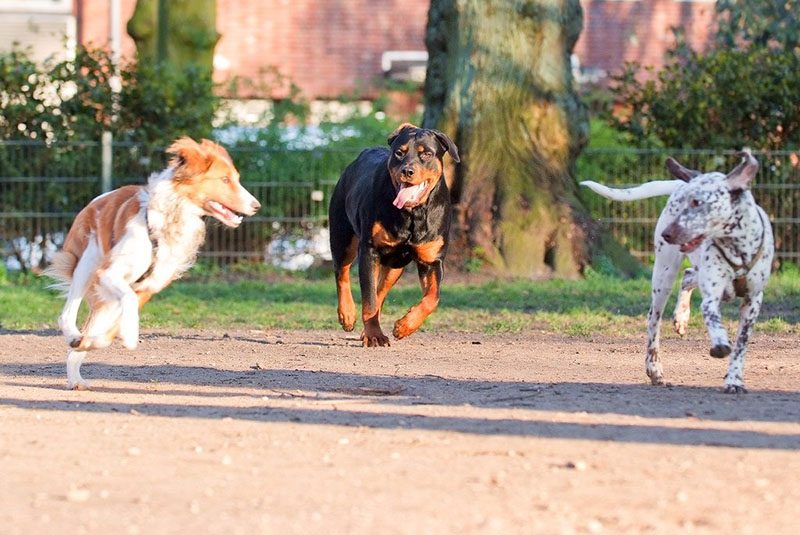
How To Care For Rottweiler Puppies
Suppose that you have decided that a Rottweiler puppy is a suitable new member of your family. Let’s go through how to care for the breed properly with information on their nutrition, grooming, exercise, training, and health!
- Nutrition:
Rottweilers can eat any type of diet, whether it be homemade or factory-produced. You will not have to worry about switching up its meals at every stage of the dog’s growth.
However, you need to watch out for the dog’s calorie intake and portion size since the breed can become obese very easily. This can be done by weighing the nutrition intake of the meal you prepare and watching the pup’s weight frequently. While making your dog’s meals, you should also see if certain human foods are safe for dog consumption.
Always leave a bowl of fresh, clean water for your Rottie to get hydrated. Especially in summer, your dog can get dehydrated very fast, so don’t forget to refill the bowl every few hours. You don’t have to keep a running tab for Rotties since they are willing to drink from still water.
Normally, you should feed large breed puppies due to their body weight of about 200-250g/10lbs. The diet can be different for each dog’s needs and nutritional requirements, but generally, you should get protein and oil into the mix. You do not want to include a few foods in your dog’s meal, such as xylitol, caffeine, chocolate, grapes, salty snacks, nuts, and alcohol.
If you have any questions regarding a dog’s diet and what food to avoid, you can always consult a veterinarian for a safe meal plan!
- Grooming:
Normally, Rottweiler dogs have straight, coarse, and short coats. At first glance, you won’t even notice the fur since the hair all lay flat on the dog’s skin. But if you look closely, you will even notice an undercoat on the neck and thighs of the dog.
A Rottweiler’s fur markings are quite remarkable as well. They surround the dog’s eye, cheeks, muzzles, chest, and legs, and their colours range from dark rust to light mahogany. These patches make a Rottweiler stand out from the crowd and factor into the breed’s overall cuteness!

Due to these characteristics of their fur coat, Rottweilers don’t need extra bathing beside a regular bath and weekly brushing. Hence, you only need to make sure that the dog’s coat remains shiny and light.
Shedding varies greatly among the breed: some might shed all year long, but some will only shed a few months per year. Therefore, the usual stench from fur scatters is not a concern. But thanks to the diverse meals the dog eats, its teeth need to be brushed every two days, so you won’t have a stinky face after it licks you.
You will also need to learn how to trim a Rottweiler dog’s nails. But this doesn’t necessarily mean cutting; you can simply use a grinding tool for this task! Your Rottie may react negatively to you touching its paw, but with enough patience and training, the routine should ease your dog off the worries! Moreover, if you want them to feel comfortable when training, you should know Best Dog Collar For Pulling – Top 10 You Should Buy Now.
Rottweilers don’t need much salon work to stay cute and maintained, but a trip to the professional every few months as a treat to your pup would be best!
- Exercise:
As a working breed, Rottweilers love working out. They will enjoy any physical exercises such as swimming, walking around the park, or an occasional fast-paced run to let off steam. Since they are social and athletic, they will love exercising even more if you join in on the fun!
Despite not being utilized for menial tasks anymore, Rottweiler dogs still gladly herd and train other dogs or cattle if you want. They can also pull carts and fetch objects as they have been trained to do in industrial times.
In conclusion, there are not many activities a Rottweiler dog cannot participate in. Rather, they need to work frequently to stay fit and healthy. So if you have an active lifestyle, this is the breed for you! Let’s move to the next section on training.
- Training:
If you want to adopt and train a puppy of the Rottweiler breed from a young age, you have got the right idea. Whether it’s leadership, friendliness towards other dogs, or home adaptiveness, you will need to give the puppy training before their habit shape.
You cannot rely on their nature as sociable dogs to leave Rottweilers alone throughout their lives. Thus, frequent interaction and reinforcement are key to a pup with good manners.
Other than that, Rotties are very smart and willing to learn and willing to please their owners. They pick up patterns very quickly, so you can try a variety of exercises on your pup. It is very important for your discipline to be reinforcing, stern, and fair, so your pup can learn what to do.
Specifically, there is a tip to remember while training your Rottweiler pup: They thrive on positive reinforcement and mental stimulation. Rottweiler dogs love to please you, and they get very excited upon receiving encouragement from you. Occasionally, like a curious child, the pup will even show you a “Please show me why I should do this” kind of attitude, which may come off as playful.
Just a quick side note: Feeding your pup when you and your family are eating is a great strategy to train its eating manners, as well as form a better bond between you and your canine companion. Since dogs can be very social eaters, they will prefer to eat it while you’re watching or when you’re eating to feel like you are all in the pack!
- Health:
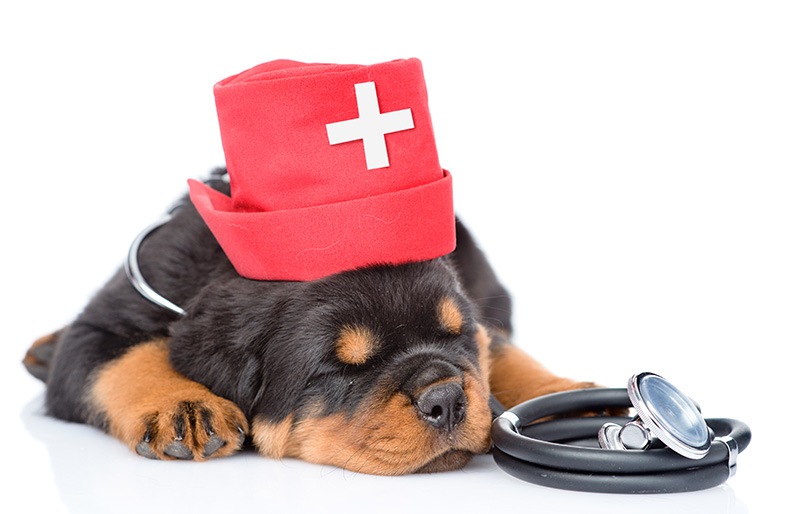
Rottweilers can be susceptible to several illnesses, especially bone-related diseases. The breed is frequently seen at a vet clinic due to hip dysplasia – a kind of abnormality in the hip joint’s shape. The condition is heritable, meaning it can be passed down to further generations. Moreover, it can cause a lot of discomfort to the dogs of this breed and can be detected via X-Ray.
Only hip dysplasia-free Rotts are allowed to be bred, so please make sure that your breeder has a certificate for such a trait. If left untreated, Rottweilers will have a very tough time moving around, which can make the pup become easily agitated and stressed. Aside from hip dysplasia, you should also be careful of elbow dysplasia and osteosarcoma.
For these reasons, we recommend that Rottweiler’s meal plan contains food that supplements – Calcium due to the amount of bone-related diseases the breed can encounter. Aside from that, you should also let your dog attend a few periodic checkups, such as:
- Hip Evaluation
- Elbow Evaluation
- Cardiac Exam
- Ophthalmologist Evaluation
These tests should be able to let you foresee any abnormalities in your canine friend’s health. Please inquire about more information about these exams with your local veterinarian. Otherwise, you can observe your dog’s height, weight, and activeness during its time spent at your home!
Rottweiler Puppies: Outro
That is all you need to know before welcoming Rottweiler puppies into your home! We will always advise you to adopt and not breed to help your local shelters run their establishments, but your choice is up to you. Don’t you agree that a well-trained Rottweiler dog can be your best companion?
Thank you for reading this post, and please leave any comments if you have any tips about Rottweilers that you want to share with us! Follow our blog for the more interesting and useful information!

